
By Shadow Pine
On June 12, 2025, a tragedy struck the skies over Ahmedabad, India, shaking the world: Air India Flight 171, a Boeing 787 Dreamliner, crashed into a residential area near the airport, claiming 260 lives. As India’s Aircraft Accident Investigation Bureau (AAIB) races to uncover the truth, whispers from anonymous sources are already shaping a narrative, one that points fingers at the pilots. But are these leaks a genuine glimpse into the investigation, or a calculated move by aircraft giant Boeing to dodge accountability? Buckle up as we dive into the murky waters of aviation investigations, where truth is often the first casualty.
The Leak That Lit the Fuse
According to a July 9, 2025, report by The Straits Times, the AAIB’s preliminary findings, expected by July 11, zero in on the movement of the plane’s fuel control switches. These cockpit levers, manually operated by pilots, are rarely moved by accident, says U.S. aviation expert John Cox. The implication? The crash may hinge on human error, a pilot’s deliberate or mistaken action. Data from the black boxes and a Boeing-assisted simulation reportedly back this lead, painting a picture of a cockpit misstep that sent the Dreamliner spiraling.
But here’s the catch: this information comes from three unnamed sources “with knowledge of the matter,” speaking to Reuters without authorization. In a probe already criticized for its opacity, delays in downloading flight recorder data and a single press conference with no questions taken, these leaks are like fuel on a fire. They fill the information void, but at what cost?
Boeing’s Shadow Looms Large
Boeing, the maker of the ill-fated 787, has every reason to nudge the narrative away from mechanical or design flaws. The company’s stock took a hit after the crash, and as India pushes to become a global aviation hub, a blemish on the Dreamliner’s record could spell disaster. History offers a chilling precedent: in the 737 MAX crashes of 2018 and 2019, Boeing initially pinned blame on pilot training, only for software flaws to later take center stage. Could the same playbook be at work here?
The leaks’ focus on fuel switches feels suspiciously convenient. By highlighting a pilot-controlled mechanism, the narrative sidesteps questions about the aircraft itself, questions that deserve answers. For instance, a New York Times report noted the plane’s landing gear failed to retract fully, and an emergency ram air turbine was likely deployed, hinting at a possible loss of electrical or engine power. NDTV has also raised sabotage as a possibility under investigation. Yet these threads, which could implicate Boeing or Air India’s maintenance, are conspicuously absent from the leaked story. Coincidence, or curation?
A Public Hungry for Truth
On social media platforms, distrust is palpable. Some users allege “deliberately timed software code corruption” crippled the plane’s engines, while others claim Boeing is hiding a defect with political cover. These theories, though unproven, reflect a broader skepticism fueled by the investigation’s secrecy and Boeing’s checkered past. When the Indian government initially barred a U.N. investigator (a decision later reversed), it only deepened suspicions of a cover-up. In this vacuum, leaks become gospel, and the pilots, silent in death, risk becoming scapegoats.
The Bigger Picture
Air crashes are rarely the result of one mistake. Human error, mechanical failure, or even external factors like fuel contamination could intertwine in complex ways. The AAIB’s preliminary report, a slim four-to-five pages, won’t deliver a verdict but will outline early findings on the aircraft, crew, airport conditions, and weather. Yet the leaks’ singular focus on the cockpit oversimplifies a puzzle still missing pieces. The final report, due months from now, may reveal a different story, if politics and corporate interests don’t cloud the lens.
What’s at Stake?
The Air India crash isn’t just about one flight; it’s about trust in aviation. For families grieving in Ahmedabad, for passengers boarding 787s worldwide, and for a nation striving for aviation greatness, the truth matters. If Boeing or other players are steering the narrative through selective leaks, they’re betting against accountability, and history shows that bet rarely pays off. The 737 MAX saga grounded planes and cost Boeing billions, but only after public outcry forced transparency.
The Call to Action
As the AAIB prepares to release its preliminary report, we must demand more than whispers from shadows. Cross-check leaks against broader reports, like those from The New York Times or NDTV. Question why certain details dominate while others fade. Watch Boeing’s role in the investigation, from its simulations to its public statements. And on social media platforms, where voices clash and theories swirl, let’s amplify reason over rumor.
The truth about Air India Flight 171 won’t come easily. But if we let leaks write the story, we risk burying it before it’s found. For the 260 lives lost, we owe it to keep digging.

Shadow Pine is an independent investigative journalist dedicated to uncovering hidden truths, especially in high-stakes and controversial matters. Operating discreetly to protect sources and maintain integrity, Shadow Pine focuses on stories that others might shy away from, aiming to bring clarity and accountability to the forefront for the well being of the nation.
The views expressed here are solely the author’s and not necessarily that of Weekly Echo’s.